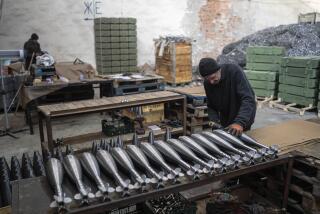Helping Gorbachev--a Capital Idea : Arms Control Can Create a Flow Toward Domestic Economy
- Share via
“It is a rule that holds in the economy as well as in hydraulics,” wrote Emerson, “that you must have a source higher than your tap.”
In the strange new marketplace where Americans and Soviets are increasingly selling things to each other and buying things from each other, the source that feeds the economic flow may not be dollars and rubles, capitalist greed or communist consumer demand, or the invisible hand of the market. It may instead be dramatic nuclear arms reductions--and the personal vision of Mikhail S. Gorbachev.
By all accounts, the Soviet economic tap had better start running more freely, and soon. Because, in the transition from central planning to enterprise, perestroika (restructuring) has produced longer consumer lines and leaner shelves. Bureaucrats are resentful, fearing loss of their jobs, and factory workers face dislocation.
No one seems to know the length of the lead time between increased democratization and competitiveness in the factory and farm and increased quantity and quality in the shop and store.
One suspects Gorbachev knows that the time lag could be dangerously long. Thus the need for foreign--particularly Western--investment, technology and management, and the magical notion of “joint ventures.” The Soviets are now keen to have Western manufacturing interests join with quasi-corporate Soviet entities, which are supposed to provide labor, raw materials, infrastructures and markets.
The problem is, the Soviets don’t know how to do this. And the various ministries’ bureaucrats see the new “capitalist, free-enterprise” entities threatening them with loss of control. Moreover, traditional Russian paranoia resists Western intrusion.
Given this backwardness in innovation, this low productivity, this inferior standard of living, this inefficiency in distribution, the stunning question is how the Soviet Union can represent such a threat to the world. That answer is twofold: The best technology, resources and minds have been dedicated to the military; and, heresy of heresies, perhaps the threat is not as great as we’ve been told.
Gorbachev seeks to raise the source higher than the tap by restructuring the Soviet economy and re-allocating resources from military to domestic needs. We’d be mistaken to underestimate the titanic scope of this effort. And it requires our cooperation in two ways: commitment to substantial nuclear arms reduction, and introduction of sophisticated production techniques into that primitive economy.
The political question for the United States is whether it is in our interest to cooperate.
I can hardly imagine how it is not.
There’s a heavy burden on the hardliner who argues for an expanded arms race (particularly now that Ronald Reagan has discovered the mainstream of detente), or who tells corporate America to reject a market of 260 million Soviets hungry for everything from pizzas to computers.
The test for the United States is whether we can sufficiently overcome traditional ideological biases to tell when Gorbachev’s interests coincide with ours, and then aggressively take advantage of these coincidences.
The test for the Soviets--and particularly a Gorbachev government experiencing internal stress--is to achieve dramatic arms reductions, shift resources to meet consumer needs, introduce novel notions such as competitiveness, demand productivity in an unproductive environment and open a reclusive society to the kaleidoscope of Western innovation.
The test for Gorbachev, in short, is to create the source while raising it above the tap. And that is far and away the most exciting act in town, with implications for the United States as far into the future as we can see.
More to Read
Sign up for Essential California
The most important California stories and recommendations in your inbox every morning.
You may occasionally receive promotional content from the Los Angeles Times.










